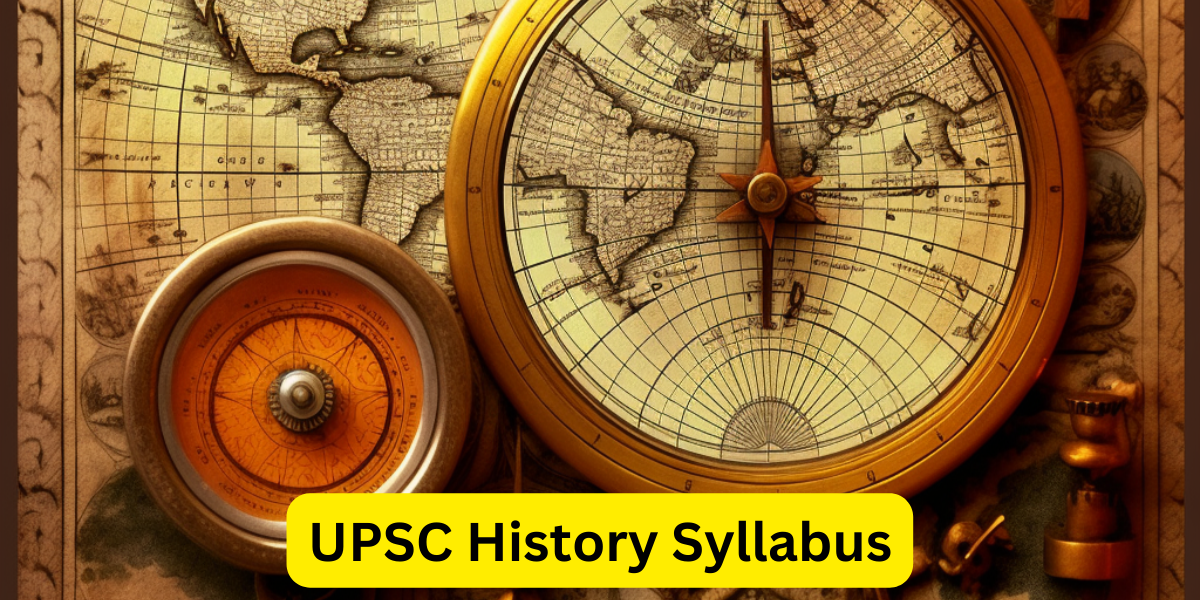Check the UPSC History Syllabus 2026 for Prelims, Mains, and Optional. Download the PDF, get section-wise topics from Ancient to Modern history, and follow expert preparation tips to strengthen your UPSC strategy for GS Paper I and Optional Papers.

UPSC History Syllabus is an integral part of the Civil Services Examination conducted by the Union Public Service Commission. It encompasses a detailed understanding of India’s ancient, medieval, and modern past, helping aspirants to build contextual knowledge for both the Prelims and Mains stages. For those opting for History as an optional subject, the syllabus extends further to demand analytical depth and comparative understanding of historical processes.
Interested candidates must read on to get a detailed insight into the UPSC History Syllabus 2025, including section-wise breakdowns, preparation tips, and access to the UPSC History Syllabus 2026 PDF Download.
The UPSC History Syllabus is designed to test the candidate’s knowledge of historical events, processes, and interpretations from ancient to modern times. It covers political, economic, social, and cultural dimensions of history both in the Indian context and globally. The syllabus is divided mainly into two papers: Paper 1 focuses on ancient and medieval Indian history, while Paper 2 concentrates on modern Indian history and world history.
The UPSC History Syllabus 2025 includes not only the factual narrative but also demands analytical skills, critical evaluation of historical sources, and the ability to interpret historiographical debates. Candidates must present coherent arguments backed by historical evidence.
| UPSC History Syllabus Overview | |
| Component | Details |
| Exam Stages Covered | Prelims, Mains (GS Paper I), Optional (Paper I & II) |
| Prelims Focus Areas | Ancient, Medieval, and Modern Indian History |
| Mains (GS Paper I) | Indian culture, Modern Indian history, Freedom struggle, Post-independence developments, World history |
| Optional Paper I | Ancient and Medieval Indian History (themes, dynasties, socio-cultural trends) |
| Optional Paper II | Modern Indian History, Indian Freedom Struggle, World History (18th–20th century events) |
| Key Subtopics in Prelims | Indus Valley, Vedic Age, Mauryas, Guptas, Delhi Sultanate, Mughals, British India, 1857 Revolt, Indian National Movement |
| Key Subtopics in the Mains | Art & Architecture, Literature, Modern reforms, World Wars, Colonisation & Decolonisation |
| Recommended for Optional | Yes – For candidates with a strong interest in historical analysis and essay-type writing |
Indian History Books for UPSC, Complete Book
Aspirants can access the UPSC History Syllabus 2026 PDF Download directly from the official UPSC website or from the direct link given below, offering well-structured and categorised versions for Prelims, Mains, and Optional subjects.
| UPSC History Syllabus 2026 PDF Download |
| Click Here (Inactive) |
This helps in maintaining a structured approach and ensuring that the preparation aligns exactly with the prescribed syllabus.
The UPSC History Prelims Syllabus 2026 forms a critical component of the General Studies Paper I in the Preliminary Examination. It evaluates a candidate’s understanding of significant historical events, socio-political movements, cultural developments, and contributions of empires and individuals that shaped Indian civilisation. A chronological and thematic understanding of Ancient, Medieval, and Modern Indian History is essential for success.
UPSC Optional PYQs PDFs Download For History
The UPSC History Optional Syllabus 2026 offers aspirants a rigorous and comprehensive framework to study history in depth, covering ancient, medieval, and modern periods of both Indian and world history. This syllabus is structured into two papers, each designed to develop a fine understanding of historical processes, sources, and interpretations.
Paper 1 focuses on the chronological evolution of Indian history from prehistoric times through the medieval period, emphasising political, social, economic, cultural, and religious aspects. The syllabus is designed to encourage critical engagement with historical sources and historiography.
Paper 2 examines modern Indian history from European penetration to contemporary times and includes a comprehensive study of world history covering major political, economic, social, and cultural developments globally.
Here are strategic Preparation Tips for the UPSC History Syllabus 2026 to ensure a thorough understanding and effective revision:
Check Out UPSC CSE Books
Visit PW Store
A thorough understanding of the UPSC History Syllabus is essential to qualify in the Civil Services Examination. Whether you are preparing for the UPSC History Prelims Syllabus 2025, UPSC History Mains Syllabus 2026, or the UPSC History Optional Syllabus 2025, a focused and structured approach can significantly enhance your preparation. Utilise the official UPSC History Syllabus 2026 PDF Download and follow the preparation tips outlined above to stay on track with your goals.
Ready to boost your UPSC 2026 preparation? Join PW’s UPSC online courses today!
The UPSC History Prelims Syllabus 2025 includes Ancient, Medieval, and Modern Indian history with a focus on socio-cultural and political developments.
You can access the UPSC History Syllabus 2025 PDF Download from the official UPSC website or from trusted UPSC preparation platforms.
The UPSC History Mains Syllabus 2025 is more analytical, with deeper focus on causes, consequences, and historiography of key historical events.
The UPSC History Optional Syllabus 2025 includes world history, Indian history from ancient to modern, historiography, and critical interpretations.
Begin your Preparation for UPSC History Syllabus 2025 by studying NCERTs, referring to standard books like Bipin Chandra, and practicing previous year questions.
Yes, Ancient History is a core component of the UPSC History Syllabus 2025, especially for Prelims and Optional, covering Vedic age, Mauryas, and Guptas.

<div class="new-fform">
</div>